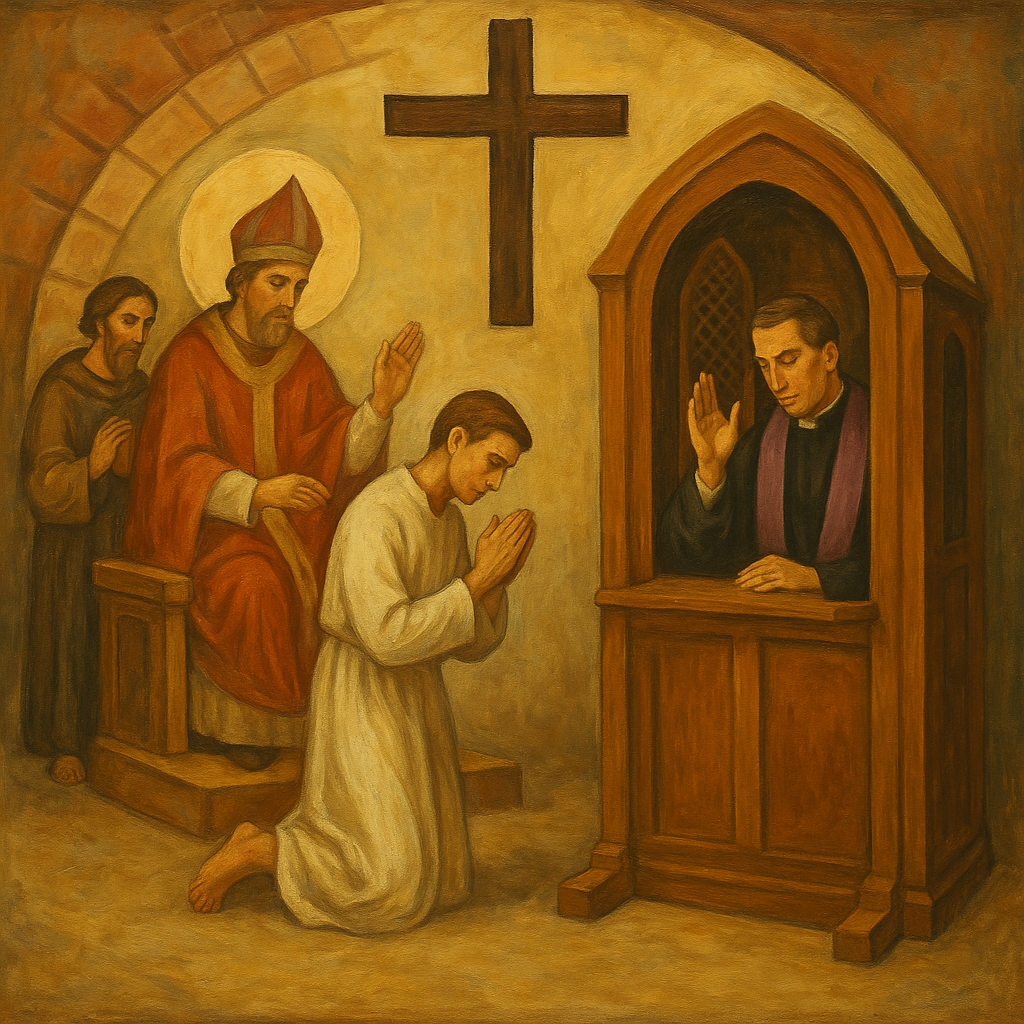
The practice of confession within the Christian Church has undergone a remarkable transformation. What began in the early centuries as a rare and communal act of repentance slowly evolved into a mandatory and sacramental institution. While originally meant to restore a believer to the fellowship of the Church after a serious moral failure, confession eventually came to be viewed as a required rite for forgiveness and salvation itself. This shift, deeply tied to ecclesiastical authority and sacramental theology, reveals much about how the Church developed its understanding of sin, grace, and belonging to the body of Christ.
Confession in the Early Church: A Matter of Discipline and Fellowship
In the Apostolic Period and the immediate generations that followed, confession was understood primarily as a form of public discipline. A Christian who had committed a grave sin, particularly apostasy during persecution, murder, or adultery, was cut off from the community and barred from the Eucharist. If the person repented sincerely, they could enter a long and grueling process of public penance, often lasting years. Only upon its completion would they be reconciled to the Church, usually through a formal act by the bishop.
Delivering to Satan: Exclusion as a Call to Repentance
This framework rested on the understanding that the Church was the visible body of Christ, the gathered community of the saved. To be excluded from that body was to be in spiritual danger, though not necessarily beyond redemption. Paul’s instruction in 1 Corinthians 5 to deliver the unrepentant sinner “to Satan” was not a declaration of eternal doom but a disciplinary act aimed at awakening the sinner to the gravity of their actions. The hope was that such exclusion would lead to genuine repentance and eventual restoration. This pastoral impulse remained central to the Church’s practice for centuries, even as confession gradually evolved.
The Shift to Private and Repeatable Confession
During the fifth through ninth centuries, a significant change began to emerge. In the monastic communities of Ireland and Anglo-Saxon England, a more private and therapeutic model of confession developed. Rather than undergoing a single, public act of penance for major sins, Christians began to confess regularly and privately to a spiritual advisor. These confessors often used penitential manuals, collections of sins and corresponding acts of penance, to prescribe disciplines suited to the individual’s failings. The emphasis shifted from dramatic acts of restoration to repeatable spiritual maintenance. This new model spread across Western Europe and gradually replaced the once-in-a-lifetime, public form of penance.
Even then, confession was not yet universally treated as a sacrament in the modern sense. It was seen as a pastoral tool, a means of personal healing and accountability. The idea that it was required for salvation had not yet been dogmatically declared, though in practice it was increasingly treated as essential to the Christian life.
Confession Becomes Obligatory: The Fourth Lateran Council
By the early thirteenth century, infant baptism had become universal in the Western Church. Baptism was believed to cleanse all sin, yet since it could be received only once, the question of how to deal with sins committed afterward became pressing. Penance and confession had already developed as the “second plank after shipwreck,” but their practice varied widely. At the Fourth Lateran Council in 1215, Pope Innocent III brought clarity and uniformity by requiring all Christians who had reached the age of reason to confess their sins at least once per year. Those who failed to do so were barred from communion and considered outside the Church’s grace. From this point, confession was no longer optional or reserved for rare cases of serious sin. It became mandatory, and priests were the exclusive agents authorized to grant absolution. To die in a state of mortal sin without confession and absolution was now believed to result in eternal separation from God.
The Council of Trent and the Sacramental Definition
The process was formalized further during the sixteenth-century Council of Trent, which responded to the Protestant Reformation by reaffirming the sacramental system. The council declared that confession, or the Sacrament of Penance, was instituted by Christ Himself and necessary for the forgiveness of mortal sins committed after baptism. It was not enough to confess directly to God; forgiveness came through the Church, through the priest, and through the performance of assigned penance. By this point, confession had been fully integrated into the Church’s theological framework as a condition for salvation itself.
Confession in the Eastern Orthodox Tradition
In the Eastern Orthodox Church, confession developed differently than in the West. It was always regarded as a vital practice of repentance, yet it did not take on the same juridical, legal character that it did in Roman Catholicism. The Orthodox emphasize confession as a sacrament of healing and restoration rather than a courtroom act. The priest is not understood as a judge but as a witness and spiritual physician who stands beside the penitent, usually before an icon of Christ, and intercedes in prayer.
Because baptism in the East was also administered to infants, the need for repentance after baptism was recognized, but the solution never became as rigidly defined as in the Latin Church. Confession remained a repeatable practice, often tied to preparation for the Eucharist, yet there was no universal requirement like the annual mandate established at the Fourth Lateran Council. Nor did the Orthodox ever declare that dying without confession automatically resulted in damnation. Instead, the focus remained on the heart’s contrition and God’s mercy, with confession serving as an important though not mechanically necessary act of renewal.
The Biblical Witness and the Question of Believing Loyalty
This historical evolution stands in tension with the way confession is described in the New Testament. While Scripture clearly upholds the value of confessing sins, both to God and to one another, it never frames it as a sacrament upon which salvation hinges. Salvation is consistently presented as the result of grace through faith, a matter of believing loyalty to Jesus Christ rather than ritual compliance. The New Testament calls believers to ongoing repentance, but it presents that repentance as relational, not sacramental. Confession, then, is best understood biblically as part of the believer’s walk of faith, a means of returning to covenantal faithfulness after sin, not a mechanical necessity for avoiding hell.
Conclusion
The shift from restorative discipline to sacramental requirement reveals both the strengths and dangers of institutional development. On one hand, the Church sought to provide structure and clarity for the spiritual lives of believers. On the other hand, it risked turning grace into obligation and repentance into ritual. Understanding this historical journey allows modern readers to appreciate the seriousness with which the early Church treated sin and restoration, while also reclaiming the biblical emphasis on faith, humility, and loyalty to Christ as the true foundation of forgiveness.
Discussion Questions
- How did the early Church’s emphasis on public confession reflect its understanding of the seriousness of sin and the holiness of the community?
- What does Paul’s instruction in 1 Corinthians 5 about “delivering to Satan” teach us about discipline and restoration within the Church?
- How did the move from public, once-in-a-lifetime penance to private, repeatable confession reshape the Christian experience of repentance?
- In what ways did the Fourth Lateran Council and the Council of Trent alter the theological understanding of confession, and how did this affect the average believer?
- How does the New Testament emphasis on grace through faith challenge or affirm the later sacramental system of confession?
Want to Know More?
- Tertullian, On Repentance – An early Father writing about post-baptismal sin, penance, and the limits of forgiveness.
- Cyprian of Carthage, On the Lapsed – A third-century North African bishop addressing those who denied Christ during persecution and the process of reconciliation.
- Henry Chadwick, The Early Church – A classic scholarly overview of early Christian practices, including penance and confession.
- Thomas N. Tentler, Sin and Confession on the Eve of the Reformation – A detailed study of late medieval Catholic practice before Luther’s challenge.
- Joseph Martos, Doors to the Sacred: A Historical Introduction to Sacraments in the Catholic Church – A modern historical overview of how confession and the other sacraments developed over time.




